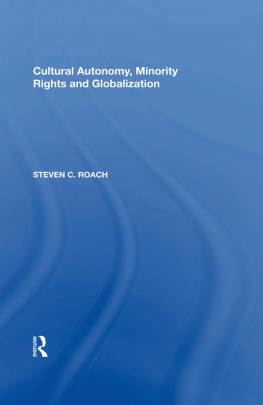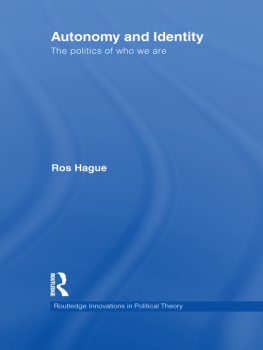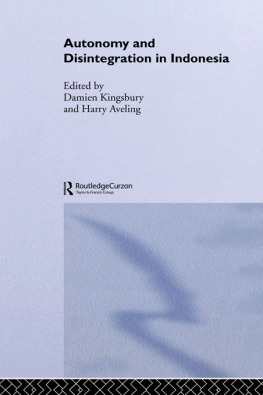Cultural Autonomy, Minority Rights and Globalization
In memory of my Father and Connie
First published 2005 by Ashgate Publishing
Reissued 2018 by Routledge
2 Park Square, Milton Park, Abingdon, Oxon OX14 4RN
711 Third Avenue, New York, NY 10017, USA
Routledge is an imprint of the Taylor & Francis Group, an informa business
Steven C. Roach 2005
Steven C. Roach has asserted his right under the Copyright, Designs and Patents Act, 1988, to be identified as the author of this work.
All rights reserved. No part of this book may be reprinted or reproduced or utilised in any form or by any electronic, mechanical, or other means, now known or hereafter invented, including photocopying and recording, or in any information storage or retrieval system, without permission in writing from the publishers.
A Library of Congress record exists under LC control number: 2005000967
Notice:
Product or corporate names may be trademarks or registered trademarks, and are used only for identification and explanation without intent to infringe.
Publishers Note
The publisher has gone to great lengths to ensure the quality of this reprint but points out that some imperfections in the original copies may be apparent.
Disclaimer
The publisher has made every effort to trace copyright holders and welcomes correspondence from those they have been unable to contact.
ISBN 13: 978-0-815-38837-1 (hbk)
ISBN 13: 978-1-351-16048-3 (ebk)
One of the great political challenges of the 20th century has been the struggle to contain national and ethnic conflict. For scholars, practitioners and students, this challenge poses many difficult questions. Perhaps the most important is how to delimit state sovereignty in terms of the severe abuse of minority rights, without at the same time undermining state sovereignty as a legal construct of international relations. Indeed, it is out of this question of sovereignty, one might argue, that our ethical commitment to promote minority rights will likely evolve. The central aim of this book, then, is to understand the social, political and global dimensions of this commitment, by investigating the prospects for an effective transnational regime of minority rights.
As of the writing of this book, several important developments have emerged that will likely challenge the way that policymakers and practitioners address minority rights issues in the future. First, the European Constitution, which was formally adopted on October 29, 2004, provides the most significant, potentially important transnational model of minority rights protection. At this point in time, it offers us a worthwhile model for imagining the convergence between global citizenship and the prospects for the global enforcement of minority rights. Indeed, it could be said that we have arrived at a critical historical juncture in which global constitutionalism reflects the concrete possibilities of globalizing minority rights.
Another important development concerns the rise of (imported) Islamic extremism in liberal democracies. Here one can point to the increasingly fragile nature of liberal democracies in their struggle to find the proper balance between tolerance and national security. It is worth stressing here that when we consign the democratic principles of tolerance and freeedom to security and fear, we also risk undermining the flexibility of these principles. In effect, by (over)stressing national security, we risk losing the integrity and strength of the very democratic principles that have allowed us to appreciate the threat posed by Islamic extremism. John Kerry, then, may well have been voicing this concern, when, during the 2004 U.S. presidential election campaign, he referred to the risks of terrorism as a nuisance.
Nonetheless, I do realize that the connection between terrorism and minority rights is anything but clearcut. But it is also true that expanding the recognition of minority rights will depend on sustaining the spirit of democratic principles, and vice versa. Such a factor will become increasingly important as globalization provides new opportunities for minority rights representation. To this end, because states must learn to define the limits of their own sovereignty in terms of the protection of international minority rights norms, so too must they learn, in conjunction with global authorities, to mediate ethnic conflict effectively. For, as history has shown, the moral and economic costs of assimilation are always higher than those associated with ethnic accommodation.
Finally, I would like to express my gratitude to those that have helped support the writing of this book. Indeed, the completion of this book would not have been possible without the editorial assistance and advice of my wife, Erica. For all her patience and loving support in seeing this manuscript through, I am forever grateful. There are also many others who have contributed to the writing and completion of this book. In particular, I am especially thankful to Micheline Ishay for all her insightful comments on earlier drafts; and to Jack Donnelly for his trenchant criticism and sobering suggestions on earlier versions of the book manuscript.
I would also like to thank colleagues and friends including Josef Chytry, Dan DeCristoforo, Tom Farer, Robert Hazan, Gary Herbert, Marcelo Hoffman, Miles Hogan, Kirstin Howgate, Derrick Hudson, Erik Knud J0rgenson, Phil Kohlenberg, Margaret Leahy, Jim Moulton, Ved Nanda, Bea Spade, Paul Timmermans, and several anonynmous reviewers, who have offered suggestions, comments, and/or inspirational support, along the way. Perhaps most important, is the enduring good will of my mother whose own political queries (and quips) kept me up at night for no better reason than to sharpen my own grasp of international issues and events. Lastly, I have dedicated this book to the memory of my Father and Aunt Connie; their brilliance, perseverance, and charming wit will forever stand as the measure of my own intellectual resolve.
One cannot analyze the current dynamics of cultural autonomy without studying the political and economic dimensions of globalization. Indeed, global technologies (e.g., the internet, media, and satellites), the mobility of capital, stronger human rights norms, and regional integration have all facilated access to information across national boundaries. Perhaps this explains why so many scholars and practitioners have focused attention on the relationship between globalization and cultural rights (Monshippouri, Englehart, Nathan, Philip 2003; Brysk, 2002; Goonsakera, Hamelink, Iyer, 2002; Held and McGrew, 1999); or rather, why there has been increasing scholarly interest in studying the historical and social dimensions of the demands of minority groups, ranging from affirmative action and cultural autonomy to regional autonomy and secession (Ishay, 2004; Jenne, 2004; Dahbour; 2003; Knop, 2002; Ragan, 2002).
Yet, in recent years, Islamic extremism has begun to infiltrate national secessionist movements (e.g., Chechnya). This has created an highly unstable political situation in many post-Soviet states, and allowed an arguably more violent and viable form of secessionism to take root. Thus, the issue of whether regional autonomy will provide an effective, long-term alternative to secession becomes all the more important to address. For we need to begin defining and envisioning how the flexible traits of cultural rights will counter the rigid (increasingly harsh) effects of secessionism and even regional autonomy. It is important, then, to realize how certain demands constitute mechanisms of conflict resolution; and how the flexibility of these mechanisms remedy the social and global effects of national secession and the majority groups inflexible intolerance of other minorities (e.g., global ethnic strife, social deprivation and severe discrimination).










